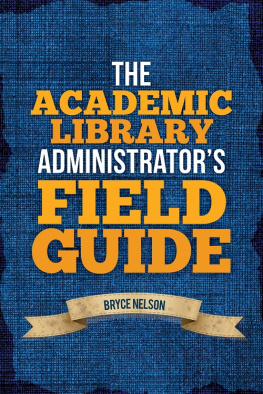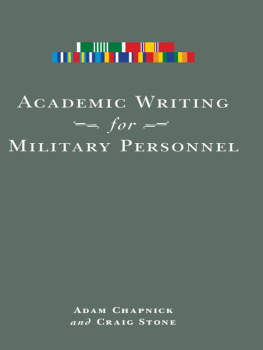Academic Leadership in
Higher Education
Academic Leadership in
Higher Education
From the Top Down
and the Bottom Up
Edited by Robert J. Sternberg, Elizabeth Davis, April C. Mason, Robert V. Smith,
Jeffrey S. Vitter, and Michele Wheatly
ROWMAN & LITTLEFIELD
Lanham Boulder New York London
Published by Rowman & Littlefield
A wholly owned subsidiary of The Rowman & Littlefield Publishing Group, Inc.
4501 Forbes Boulevard, Suite 200, Lanham, Maryland 20706
www.rowman.com
Unit A, Whitacre Mews, 26-34 Stannary Street, London SE11 4AB
Copyright 2015 by Robert J. Sternberg, Elizabeth Davis, April C. Mason, Robert V. Smith, Jeffrey S. Vitter, and Michele Wheatly
All rights reserved. No part of this book may be reproduced in any form or by any electronic or mechanical means, including information storage and retrieval systems, without written permission from the publisher, except by a reviewer who may quote passages in a review.
British Library Cataloguing in Publication Information Available
Library of Congress Cataloging-in-Publication Data Available
ISBN 978-1-4758-0803-2 (cloth : alk. paper)
ISBN 978-1-4758-0804-9 (pbk. : alk. paper)
ISBN 978-1-4758-0805-6 (electronic)
 TM The paper used in this publication meets the minimum requirements of American National Standard for Information Sciences Permanence of Paper for Printed Library Materials, ANSI/NISO Z39.48-1992.
TM The paper used in this publication meets the minimum requirements of American National Standard for Information Sciences Permanence of Paper for Printed Library Materials, ANSI/NISO Z39.48-1992.
Printed in the United States of America
Preface
Now what should I do? This is a question academic leaders ask themselves with great regularity. As ironic as it may seem, very few academic leaders have had any formal training in academic administration, or in any kind of administration at all. For the most part, academic administrators learn on the job. They also seek advice wherever they can get it. The purpose of this book is to offer such advice.
About Our Book
In May of 2013, when Bob Sternberg was provost and senior vice president of Oklahoma State University, he wrote to all of the provosts of the Big XII universities asking them whether they would be interested in collaborating in editing a brief book providing advice to academic leaders at all levels, from department chairs, up through deans, provosts, and presidents. The idea proffered was to seek out academic administrators at various levels and types of institutions and ask them to write brief chapters providing advice, especially but not exclusively to those newly starting out in their positions.
All of the Big XII provosts, as of May 2013, agreed to take part as coeditors of the book. But, life has a way of intervening, and in the meantime some of the provosts left for other positions and other provosts left administration altogether. Some other provosts just got busy with alternative endeavors. In the end, six (past and present) Big XII provosts stayed with the book. Thus, the book has continued on, and you are reading it now. The book is written both for academic administrators at all levels and for those who aspire to academic administration.
We have divided the book into six parts.
Part I comprises an introductory chapter by Elizabeth Hoffman, formerly provost at one of the Big XII universities, Iowa State. (Hoffman also is a past president of the University of Colorado.) She provides a panoramic overview of the chapters in the book.
Part II provides advice from (present and past) presidents and chancellors, that is, chief executive officers of universities. These individuals have a telescopic or wide-ranging view of all of the functions of a university.
Part III furnishes advice from present and former provosts, that is, chief academic officers. These individuals probably have a more encompassing view of the academic side of their institution than does any other single person in the institution.
Part IV contains advice from present and former deans. Deans are chief executives for schools or colleges within universities and, in some institutions, are almost like presidents of portions of the institution. They differ from presidents, however, in the more limited scope of the problems they are likely to confront.
Part V offers advice from present and former department chairs and heads, the ones who, from some points of view, have the most difficult jobs in the university. They have to deal with administrative problems on the ground, and they frequently encounter those problems in their original, unfiltered, and raw forms.
Finally, part VI contains two concluding chapters: one by Jeffrey L. Buller and one by Robert J. Sternberg, one of the coeditors. These chapters summarize major points of the book.
Each of the six parts is grouped by the highest level an individual has achieved (e.g., some presidents or chancellors have been provosts, but if an individual has been or is a president or chancellor, his or her chapter is grouped with the other ones of individuals at that level). Within the provost and dean categories are included chapters by associate provosts and deans as well as full provosts and deans.
Enjoy the book! We hope you will learn as much from reading each of the chapters as we have as we prepared the book.
We are grateful to Patty Moore of Oklahoma State University for her tireless work in helping with the preparation of the book.
Robert J. Sternberg
Elizabeth Davis
April C. Mason
Robert V. Smith
Jeffrey S. Vitter
Michele Wheatly
I
Introduction
Chapter 1
What Have We Learned about Academic Leadership?
Elizabeth Hoffman
When Bob Sternberg embarked on this project in May of 2013, I was nearing the end of a years administrative leave after stepping down from my fifth major administrative position, an administrative career spanning twenty-three years. My latest position was a five-year term as executive vice president and provost at Iowa State University. I had been one of the Big XII provosts who formed the original set of contributors to this important book.
Now, a little more than a year later, only two of the original Big XII provosts who wrote for this volume are still in those positions. Some have retired, others have returned to faculty positions, and still others have moved on to other administrative positions. Yet, we have remained close friends and colleagues and Bob has wisely expanded the range of perspectives represented in these essays to include leaders representing other institutions and administrative positions ranging from department chairs and faculty members to campus presidents and chancellors.
This change makes this a much richer narrative of academic leadership, while also highlighting the similarities among the challenges we all face. So, while it is clearly true that where you stand is where you sit, as articulated by Bob Smith, it is also true that we face many similar challenges, independent of position. In this introductory chapter, I will attempt to bring together themes that permeate many, if not all, of the chapters, regardless of academic leadership position.
Strategic Planning
Strategic planning (or just planning) is probably the most pervasive theme in the book. Strategic planning may be discussed directly, as exemplified by the chapters from both the University of Kansas and Kansas State University. University of Kansas Provost Jeff Vitter writes about the importance of the process of strategic planning as a way of bringing the different constituents of the university together to define the universitys future during difficult economic times. Kansas State University Provost April Mason outlines a similar process and its importance. Both emphasize the value of having a plan whether you have the good fortune to distribute additional resources or have to respond to a budget shortfall. They agree that a plan guides resource allocation to make sure the strongest and most important areas of the university are strengthened in good times and protected, to the extent possible, in lean times.
Next page











 TM The paper used in this publication meets the minimum requirements of American National Standard for Information Sciences Permanence of Paper for Printed Library Materials, ANSI/NISO Z39.48-1992.
TM The paper used in this publication meets the minimum requirements of American National Standard for Information Sciences Permanence of Paper for Printed Library Materials, ANSI/NISO Z39.48-1992.